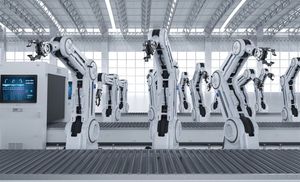
Washington D.C. – September 25, 2025 – The U.S. economy delivered a significant "hot GDP surprise" today, with the Commerce Department reporting a robust upward revision to second-quarter Gross Domestic Product (GDP) growth, now standing at an annualized rate of 3.8%. This marked a notable acceleration from earlier estimates and indicated a more resilient economic performance than many analysts had anticipated, particularly following a contraction in the first quarter of the year. While the strong headline figure signals underlying economic strength, it immediately impacted Wall Street's rally, sending bond yields higher and casting a shadow of uncertainty over the Federal Reserve's future monetary policy decisions.
This unexpected surge in economic activity has created a complex scenario for financial markets and policymakers alike. The robust growth, primarily fueled by consumer spending, suggests the economy is holding up well, yet it complicates the Federal Reserve's delicate balancing act between taming persistent inflation and supporting employment. Investors are now grappling with the implications of a potentially more hawkish Fed and the prospect of higher borrowing costs for businesses and consumers.
A Deeper Dive into the Q2 Economic Boom
The Bureau of Economic Analysis (BEA) announced today, September 25, 2025, that the third and final estimate for Q2 GDP surged to 3.8%. This figure represents a considerable jump from the initial advance estimate of 3.0% and the second estimate of 3.3%, catching many economists off guard. The primary drivers behind this upward revision were significantly stronger consumer spending and a sharp decline in imports.
Consumer spending, which accounts for roughly 70% of the U.S. economy, rose at a 2.5% annual rate in Q2, a substantial increase from previous estimates. This acceleration was particularly evident in spending on services, including transportation, financial services, and insurance, indicating that American consumers remained resilient despite broader economic headwinds. Furthermore, a dramatic 29.3% plummet in imports significantly boosted the GDP calculation, following a surge in Q1 as businesses front-loaded purchases in anticipation of new tariffs. This sequence of events, a 0.6% contraction in Q1 followed by a 3.8% rebound in Q2, highlights the significant impact of trade policy on headline GDP figures.
Key players involved in this economic narrative include the Bureau of Economic Analysis (BEA), responsible for the data, and the Federal Reserve (Fed), which closely monitors GDP to inform its monetary policy. The Treasury Department and various economists from institutions like Oxford Economics and FactSet also play crucial roles in analyzing and interpreting the data. Initial market reactions were swift: long-term bond yields, such as the 10-year U.S. Treasury, surged to 4.18%, signaling higher borrowing costs. U.S. stock indexes like the S&P 500 (NYSEARCA: SPY), Nasdaq Composite (NASDAQ: IXIC), and Dow Jones Industrial Average (NYSEARCA: DIA) all closed lower, as investors recalibrated expectations for interest rate cuts. The U.S. Dollar Index (DXY) also touched a three-week high, reflecting the perceived strength of the U.S. economy.
For workers, the strong GDP growth generally has positive implications, as a robust economy typically leads to increased demand for goods and services, creating job opportunities and potentially driving wage growth. Weekly jobless claims falling to 218,000 further underscored a resilient labor market. However, the real impact on wages will depend on how inflation behaves. For mortgage rates, the news is less favorable. The surge in bond yields directly translates to higher mortgage rates, making homeownership more expensive and reducing affordability for prospective buyers. This suggests that borrowing costs for homes may remain elevated for longer, presenting a challenge for the housing market.
Public Companies Navigating the Economic Crosscurrents
The revised 3.8% Q2 GDP growth, driven by strong consumer spending but accompanied by the specter of higher interest rates, creates a bifurcated landscape for public companies. Certain sectors and firms are poised to benefit, while others may face significant headwinds.
The financial sector stands to be a primary beneficiary. Banks like JPMorgan Chase (NYSE: JPM) and Bank of America (NYSE: BAC) thrive in higher interest rate environments due to improved net interest margins—the difference between what they earn on loans and pay on deposits. A healthy economy also typically translates to increased loan demand and fewer defaults. Insurance companies such as Allstate (NYSE: ALL) and Travelers (NYSE: TRV) could see enhanced returns on their investment portfolios, often heavily weighted in bonds. Brokerage firms like Charles Schwab (NYSE: SCHW) may also experience increased interest income from client cash balances.
Companies in the consumer discretionary sector will also feel the effects. While strong consumer spending is a tailwind for retailers and e-commerce giants like Amazon (NASDAQ: AMZN), the impact of rising interest rates on big-ticket, debt-dependent purchases could create a nuanced picture. Travel and leisure companies such as Marriott International (NASDAQ: MAR) and Delta Air Lines (NYSE: DAL) are likely to see continued demand as consumers allocate more disposable income to experiences. However, manufacturers of durable goods like automobiles, such as General Motors (NYSE: GM) and Ford Motor Company (NYSE: F), might see sales challenged by higher auto loan rates making monthly payments more expensive for consumers.
Conversely, interest-sensitive sectors, particularly real estate and construction, are likely to struggle. Higher mortgage rates directly impact housing affordability, potentially dampening demand for new homes. Homebuilders like D.R. Horton (NYSE: DRH) and Lennar (NYSE: LEN) may face reduced sales volumes and increased borrowing costs for their projects. Real Estate Investment Trusts (REITs) are also often sensitive to rising rates, as higher bond yields make their dividend payouts comparatively less attractive. The technology sector, especially growth-oriented companies and startups, could also face challenges. Many tech firms rely on projected future earnings for their valuations, and higher interest rates reduce the present value of these future cash flows, making their stocks less appealing. Furthermore, startups often depend on venture capital and debt to fuel growth, both of which become more expensive in a rising rate environment.
Wider Significance and Policy Crossroads
The revised 3.8% Q2 GDP growth holds wider significance, painting a picture of an economy at a critical juncture, balancing surprising resilience with persistent challenges. This event fits into broader industry trends characterized by reaccelerating inflation, a softening labor market, and resilient, albeit potentially polarizing, consumer spending.
Inflation remains a significant concern, with the U.S. annual inflation rate accelerating to 2.9% in August 2025, up from previous months and still above the Federal Reserve's 2% target. This persistent pressure is partly attributed to retailers passing on higher import tariffs, alongside rising energy and food costs. The robust consumer spending that fueled Q2 GDP could exacerbate these inflationary trends. In contrast, the labor market is showing clear signs of cooling, with job creation slowing and the unemployment rate edging up to 4.3%. This divergence between strong economic growth and a weakening job market presents a complex puzzle for policymakers. Consumer resilience was a key takeaway from Q2, but forecasts suggest this may weaken in the latter half of 2025, particularly for lower and middle-income groups, as tariff effects and economic uncertainty become more pronounced.
The regulatory and policy implications for the Federal Reserve are paramount. The robust Q2 GDP growth complicates the Fed's recent move to cut its benchmark federal funds rate by a quarter percentage point in September 2025. While that cut was a "risk-management" response to a weakening labor market, the stronger GDP data now dampens enthusiasm for further aggressive rate cuts. The Fed now faces a dilemma: strong growth suggests less need for easing, but reaccelerating inflation demands attention. This creates uncertainty around the Fed's "dot plot" projections, which previously indicated two more rate cuts by year-end 2025.
Historically, periods of strong GDP growth following a contraction have been common, often reflecting a rebound. However, the current mix of robust growth, elevated inflation driven by tariffs, and a cooling labor market presents a unique challenge. This specific pattern of trade-induced volatility, coupled with underlying consumer strength, makes direct historical comparisons difficult without considering the contemporary policy environment. The ripple effects extend globally, with U.S. economic strength potentially attracting foreign capital and strengthening the dollar, but ongoing trade wars creating uncertainty for trade partners and global investment.
What Comes Next: Navigating a Shifting Economic Landscape
The path forward for the U.S. economy following the robust 3.8% Q2 GDP growth is characterized by a mix of opportunities and challenges, demanding strategic pivots from businesses and cautious adaptations from consumers.
In the short-term (remainder of 2025), a moderation in economic growth is widely anticipated, with forecasts for full-year 2025 GDP growth ranging from 1.4% to 1.9%. This expected slowdown is attributed to tariff-related cost increases, persistent policy uncertainty, and elevated interest rates weighing on various economic activities. Inflation is expected to reaccelerate, with the annual rate potentially reaching 2.9% by year-end, driven by tariffs and rising service costs. Consequently, the Federal Reserve is likely to maintain a cautious stance on interest rates. While an additional rate cut in October remains a possibility, the strong Q2 GDP has reduced the urgency for aggressive easing, and the 10-year Treasury yield is expected to hover near 4.5%.
Looking long-term (2026 and beyond), the economy is projected to continue with below-trend growth, accelerating slightly in 2027 and 2028 before settling at around 1.8% by 2029. High-tech investment, particularly in artificial intelligence (AI), is seen as a significant tailwind. However, inflation is expected to remain sticky, potentially above 3% through mid-2026, and the Fed is anticipated to ease gradually into 2026, with policy rates settling around 3.1% by late 2026.
Strategic pivots for businesses will be crucial. With potentially lower borrowing costs in the future, companies can strategically invest in supply chain optimization and refinancing debt. However, the immediate challenge lies in managing labor expenses amid a slowing job market and adapting to inflationary pressures from tariffs. Innovation, especially leveraging AI and digital tools, will be key for maintaining competitiveness. For consumers, prudent debt management and cautious spending habits will be important, as the job market cools and discretionary spending polarizes between high-income and other groups.
Market opportunities may emerge in technology and AI, with high growth in intellectual property investment. Domestic production could also see a boost due to tariffs encouraging local manufacturing. However, challenges include ongoing trade policy uncertainty, persistent inflationary pressures eroding purchasing power, and a cooling labor market that could dampen overall economic momentum. Geopolitical risks and a rising federal budget deficit also add to the uncertainty. The most likely scenario is a "soft landing," where growth moderates without triggering a deep recession, but "stagflation light" (sticky inflation with slow growth) or even a "hard landing" remain possibilities.
Wrap-Up: A Resilient Economy, a Challenging Path Ahead
The revised 3.8% Q2 GDP growth paints a picture of a U.S. economy that is more resilient and on a more solid footing than many had previously believed. This "hot GDP surprise" challenges narratives of a rapidly slowing economy and supports the possibility of a "soft landing"—sustaining economic momentum without reigniting significant inflation. The strength reinforces America's position as a global economic engine.
However, this robust performance simultaneously presents a complex challenge for the Federal Reserve. The strong growth, coupled with reaccelerating inflation, complicates the Fed's dual mandate of achieving maximum employment and price stability. The market's immediate reaction, characterized by rising bond yields and a dip in equities, reflects a shift in expectations towards a potentially more cautious, or even hawkish, stance from the central bank regarding future interest rate cuts. The lasting impact will largely hinge on how this strong growth interacts with existing inflationary pressures and the Fed's response. It could lead to a prolonged period of higher interest rates than markets had anticipated, making the Fed's job of bringing inflation sustainably down to its 2% target more challenging.
Investors should exercise caution and strategically position their portfolios in the coming months. Close monitoring of the Federal Reserve's next moves, particularly their communications and "dot plot" projections, will be critical. The pace of policy adjustments will remain highly data-dependent. Inflation data, especially the upcoming Personal Consumption Expenditures (PCE) report, will be under intense scrutiny for signs of sustained progress. Labor market reports will be crucial to assess the true strength of employment and its impact on wage growth. Furthermore, trade policy and tariffs remain a significant factor, influencing supply chains and imported goods prices. Finally, investors should track corporate earnings for signs of sustained profitability and monitor the yield curve and bond market closely, as higher yields in longer-dated bonds reflect ongoing market concerns about inflation and fiscal sustainability. The delicate balance between fostering economic expansion, managing persistent inflation, and navigating Federal Reserve policy will define market performance in the coming months. Agile and diversified investment strategies, keenly attuned to incoming economic data and central bank signals, will be essential.
This content is intended for informational purposes only and is not financial advice.





